Auto Export Tab
Features in the "Auto Export" tab in Neovest's "Filter Preferences" box let you set up an automatic schedule for saving and exporting the symbols and symbol data that are displayed in the "Filter" tab in a Filter window for importing into other software applications.
Neovest lets you determine the format in which each data file is to be saved and exported. For instance, you may choose to save the contents of a Neovest Filter window in a ".csv" format, which is a standard used by other programs such as Microsoft Excel ®.
The following instructions explain how you may set up an automatic schedule for saving and exporting the symbols and symbol data that are displayed in the "Filter" tab in a Neovest Filter window:
With a Filter window open on your screen, click the gear icon, located on the far-right of the toolbar.

Click the "Preferences" icon on the drop-down menu that appears.
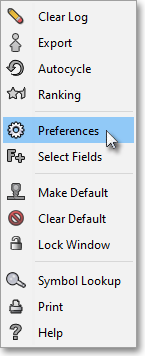
Once the "Filter Preferences" box appears, select the "Auto Export " tab.
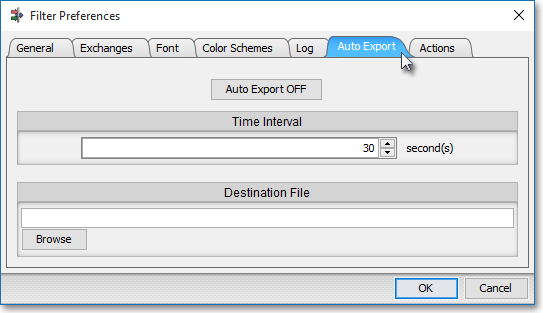
The following table provides descriptions of the features in the "Auto Export" tab:
| Feature: | Description: |
| Auto Export OFF/ON | Lets you turn the auto export feature on or off. |
| Time Interval | Lets you specify how often you wish Neovest to save and export the symbols and symbol data that are displayed in the "Filter" tab in a Filter window. |
| Destination File | Lets you specify where and under which name all exported Filter window data files are to be saved. To specify where you wish the data files to be saved, click Browse to access the "Export" box. For information on the features in the "Export" box, refer to the instructions following this table. |
Export Box Features
Once you click Browse in the "Auto Export" tab in Neovest's "Filter Preferences" box, the "Export" box will appear.
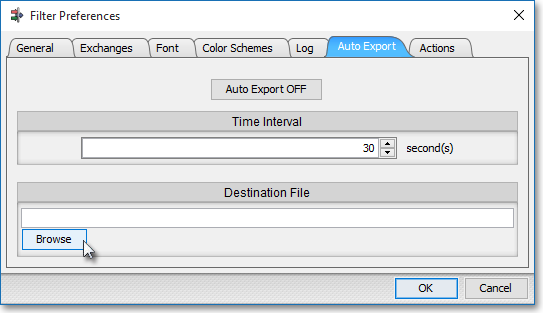
Features in the "Export" box let you specify where and under which name all exported Filter window data files are to be saved.
The following instructions explain how you may specify where and under which name all exported Filter window data files are to be saved:
Click on the "Look In" box down arrow to select the location where you wish to save the data files.
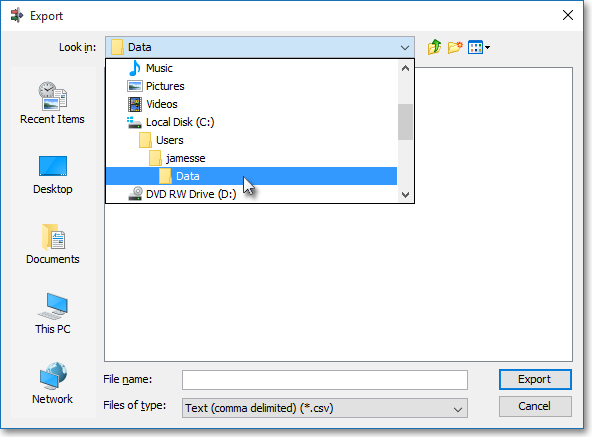
Enter the name in the "File Name" box that you wish to give the data files. (In the following example, "DataFile" is used as the name.)
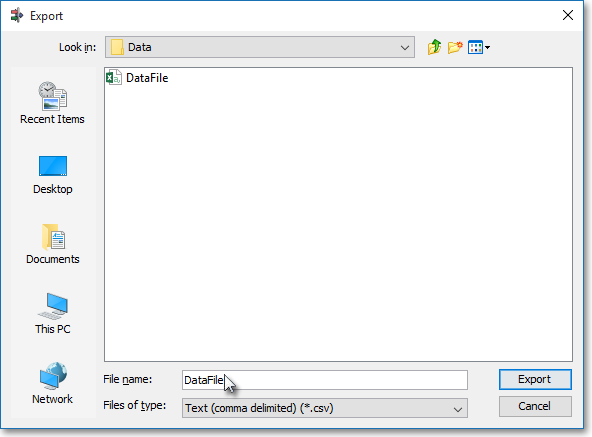
Click on the "Files of Type" down arrow to select the format in which you would like to save the data files. If you do not select a format extension for the data files, the default format extension specified in the "Files of Type" box will be appended to each file name.
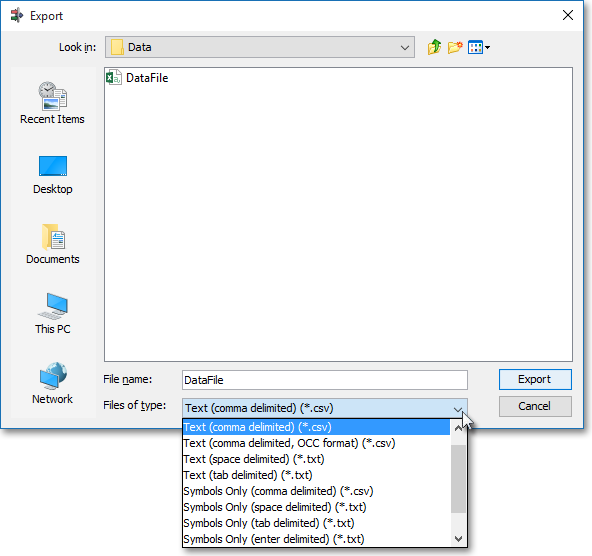
The following table provides descriptions of the data file formats that are available in the "Files of Type" menu:
| Feature: | Description: |
| Text
(comma delimited) (*.csv) |
Exports the symbols and symbol data that are displayed in the "Filter" tab in a Filter window and saves the data file in a format where each display field and item of symbol data is separated by a comma and each row of data is separated by a carriage return. |
|
Text (space delimited) (*.txt) | Exports the symbols and symbol data that are displayed in the "Filter" tab in a Filter window and saves the data file in a format where each display field and item of symbol data is separated by a space and each row of data is separated by a carriage return. |
| Text (tab delimited) (*.txt) | Exports the symbols and symbol data that are displayed in the "Filter" tab in a Filter window and saves the data file in a format where each display field and item of symbol data is separated by a tab and each row of data is separated by a carriage return. |
| Symbols Only (comma delimited) (*.csv) |
Exports only the symbols that are displayed in the "Filter" tab in a Filter window and saves the data file in a format where each symbol is separated by a comma. |
| Symbols Only (space delimited) (*.txt) |
Exports only the symbols that are displayed in the "Filter" tab in a Filter window and saves the data file in a format where each symbol is separated by a space. |
| Symbols Only (tab delimited) (*.txt) |
Exports only the symbols that are displayed in the "Filter" tab in a Filter window and saves the data file in a format where each symbol is separated by a tab. |
| Symbols Only (enter delimited) (*.txt) |
Exports only the symbols that are displayed in the "Filter" tab in a Filter window and saves the data file in a format where each symbol is separated by a carriage return. |
| DDE
(DDE Enabled) (*.csv) |
Exports
the symbols and display fields that are displayed in either the "Filter" or "Local" tab in a Filter window
and saves the data file in a format where each display field is written as a DDE
formula. Once this type of data file is exported, the file may then be loaded
into Microsoft Excel®, which will then begin to receive live symbol and display field data via Neovest. If you choose to export a data file from a Filter window, all of your display fields, in their correct order, will be included in your Microsoft Excel® spreadsheet. If you wish to manually change what any individual cell reflects, simply click in the cell and enter =NEOVEST|QUOTE![symbol].[field] in the "Insert Function" line, which is the line to the right of the  symbol. For example, if you wish to see the ask price for the symbol "LKQX," simply click in the cell where you wish the information to appear, and enter the formula: symbol. For example, if you wish to see the ask price for the symbol "LKQX," simply click in the cell where you wish the information to appear, and enter the formula:=NEOVEST|QUOTE!LKQX.ASK in the "Insert Function" line, which is the line to the right of the  symbol. Click here if you would like to see a graphic from Microsoft Excel® that shows how you may enter a formula for a particular cell. symbol. Click here if you would like to see a graphic from Microsoft Excel® that shows how you may enter a formula for a particular cell.Note (1): If the symbol for which you are trying to obtain data has a period in its name, you must include single quote marks on both sides of the symbol name and type a " / " in front of the period in the formula. For example, to obtain the last price for the symbol "XPX.X" the formula would read: =NEOVEST|QUOTE!'XPX/.X.LAST'. Note (2): Neovest must be open on your computer in order for a RTD® Microsoft Excel® spreadsheet to continue to be updated in real time. Note (3): Both RTD® and DDE formats are used to maintain spreadsheets that receive live updates from Neovest. DDE is most advantageous for spreadsheets that have individual cells that aren't reflecting the same data as the rest of the cells in that column or row. RTD® is most advantageous for spreadsheets that keep each column or row reflecting a single type of data. |
| RTD (RTD Enabled) (*.xls) |
Exports the symbols and display fields that are displayed in either the "Filter" or "Local" tab in a Filter window and saves the data file in a format where each display field is written as a RTD formula. Once this type of data file is exported, the file may then be loaded into Microsoft Excel ®, which will then begin to receive live symbol and display field data via Neovest.
If you choose to export a data file from a Filter window, all of your display fields, in their correct order, will be included in your Microsoft Excel® spreadsheet. If you wish to manually change what any individual cell reflects, simply click in the cell and enter =RTD("NeovestRTD",,"QUOTE"[$reference cell #1],[$reference cell #2] in the "Insert Function" line, which is the line to the right of the  symbol.
For example, if you wish a cell to reflect the ask price for the symbol "LKQX," and "LKQX" is found in cell A2 and the word "Ask" is found in cell B1, then you would enter the formula: =RTD("NeovestRTD",,"QUOTE",$A2,B$1) in the "Insert Function" line, which is the line to the right of the symbol.
For example, if you wish a cell to reflect the ask price for the symbol "LKQX," and "LKQX" is found in cell A2 and the word "Ask" is found in cell B1, then you would enter the formula: =RTD("NeovestRTD",,"QUOTE",$A2,B$1) in the "Insert Function" line, which is the line to the right of the  symbol. Click here if you would like to see a graphic from Microsoft Excel® that shows how you may enter a formula for a particular cell. symbol. Click here if you would like to see a graphic from Microsoft Excel® that shows how you may enter a formula for a particular cell.
Note (1): Neovest must be open on your computer in order for a RTD® Microsoft Excel® spreadsheet to continue to be updated in real time. Note (2): Both RTD® and DDE formats are used to maintain spreadsheets that receive live updates from Neovest. DDE is most advantageous for spreadsheets that have individual cells that aren't reflecting the same data as the rest of the cells in that column or row. RTD® is most advantageous for spreadsheets that keep each column or row reflecting a single type of data. |
| Excel (*.xls) | Exports the symbols and symbol data that are displayed in the "Filter" tab in a Filter window and saves the data file in a format where each display field and each item of symbol data will be displayed in its own cell, once the file is exported and loaded in a Microsoft Excel ® spreadsheet. |
Once you select the format in which you would like to save the data files, click Export.
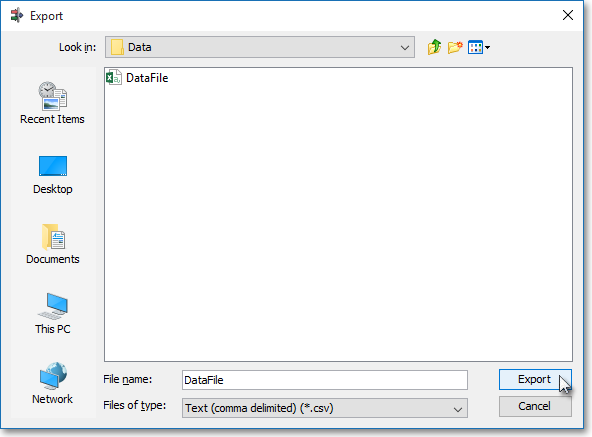
Once the "Filter Preferences" box appears, click OK.

Example of a DDE formula taken from Microsoft Excel ®:

Example of an RTD formula taken from Microsoft Excel ®:
